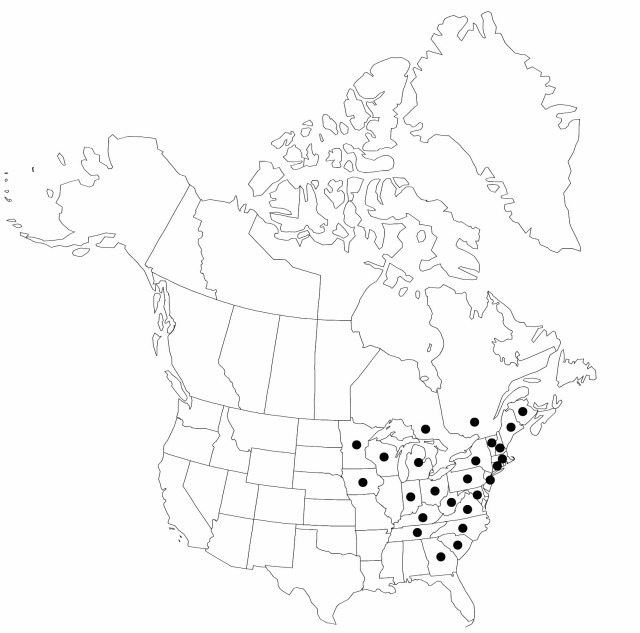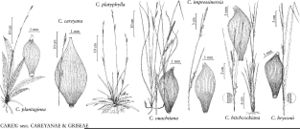Carex plantaginea
in J. Lamarck et al., Encycl. 3: 392. 1789.
Plants densely cespitose. Culms lateral, erect or ascending, usually overtopping vegetative shoots, 24–54 cm × 0.7–1 mm. Leaves: basal sheaths purple, 7–18 mm; blades erect or ascending, evergreen, midrib and 2 lateral veins strongly developed, 14–42 cm × 8–32 mm, older leaves often shriveling or dead at tips. Inflorescences: spikes 3–5 per culm, scattered; peduncle of pistillate spikes erect or spreading, rarely drooping, exserted 0–18 mm; bracts from middle and proximal portions of culms reduced, 0.8–2 cm × 2–3.5 mm. Pistillate spikes the proximal basal, 8–30 × 4–7 mm. Staminate spike 1, pedunculate, oblanceolate to linear, 8–20 × 2–3.5 mm. Pistillate scales slightly keeled, 3.2–4.2 × 1.8–2.2 mm, midribs green, margins hyaline with purple outward, apex cuspidate to acuminate to acute. Staminate scales 3–6 × 1.5–2 mm, midveins green or purple, margins dark purple, apex obtuse. Anthers 3.2–4.2 mm. Perigynia (4–)9–13(–15) per spike, overlapping, finely veined, elliptic, 3.7–4.9 × 1.6–2 mm; beak constricted. Achenes ovoid, 2.2–2.7 × 1.5–1.9 mm, sides flat to slightly concave at maturity, tightly fitting in perigynia. Style ascending from achene through entire orifice. 2n = 50, 52.
Phenology: Fruiting spring.
Habitat: Rich, moist, deciduous or mixed deciduous-evergreen forests, on slopes along streams or along edges of moist depressions, southward in mountain gorges
Elevation: 100–600 m
Distribution

N.B., Ont., Que., Conn., Ga., Ind., Iowa, Ky., Maine, Md., Mass., Mich., Minn., N.H., N.J., N.Y., N.C., Ohio, Pa., S.C., Tenn., Vt., Va., W.Va., Wis.
Discussion
Selected References
None.
